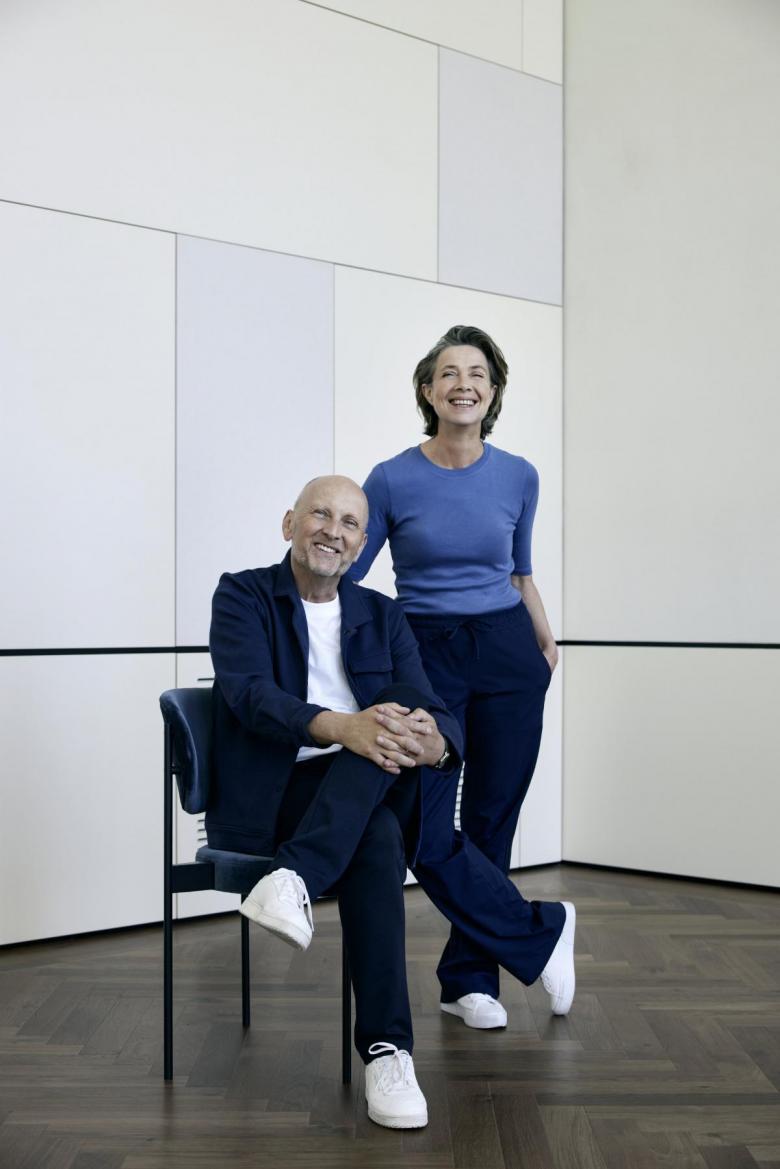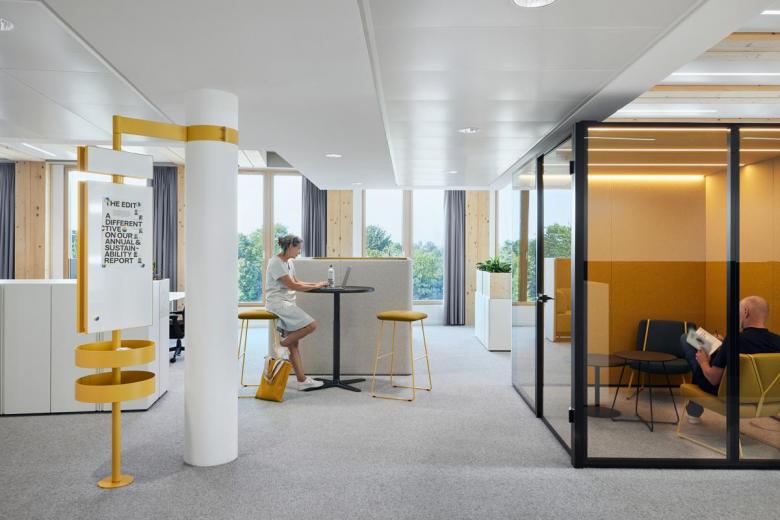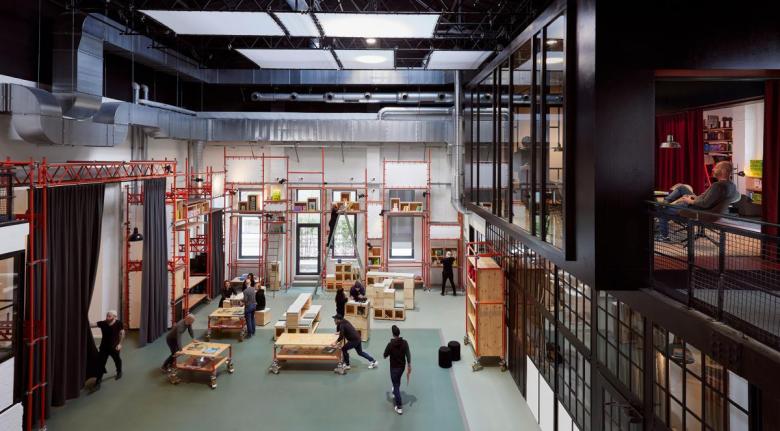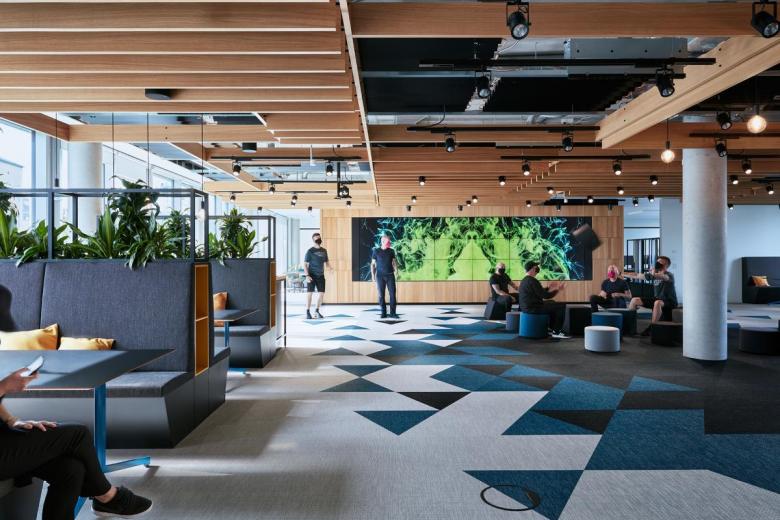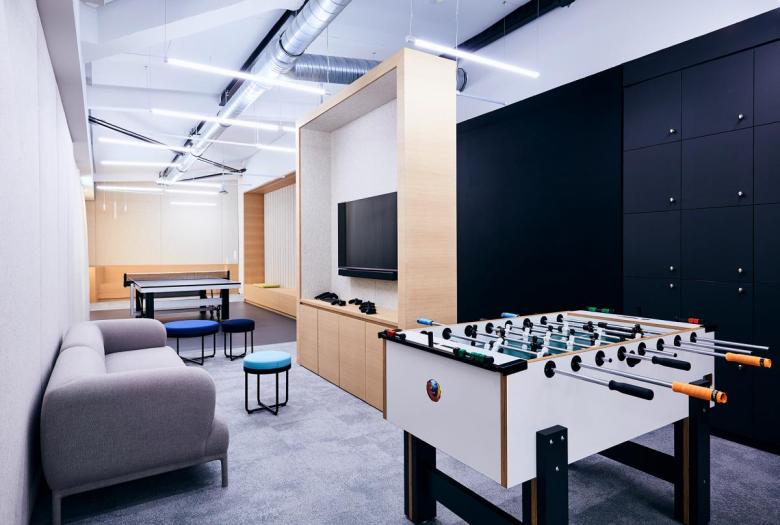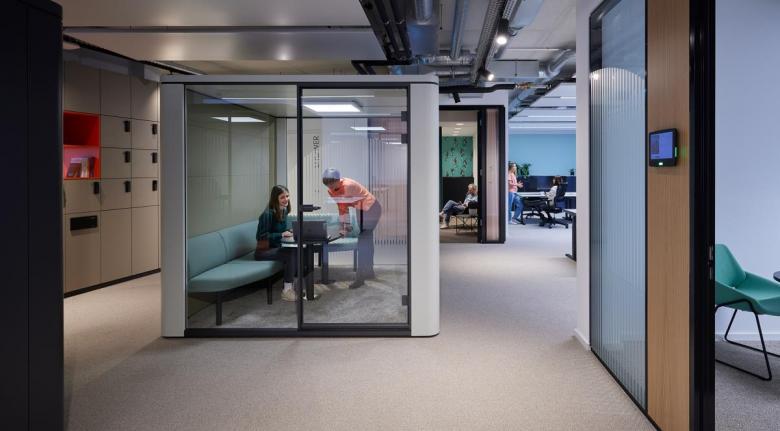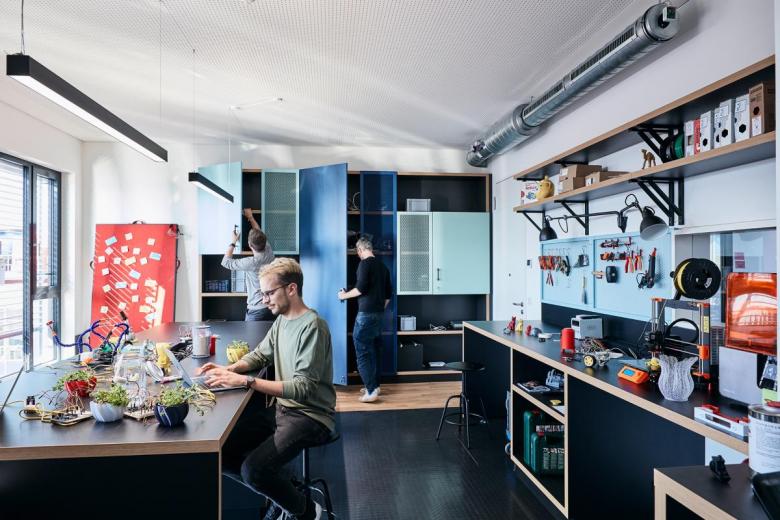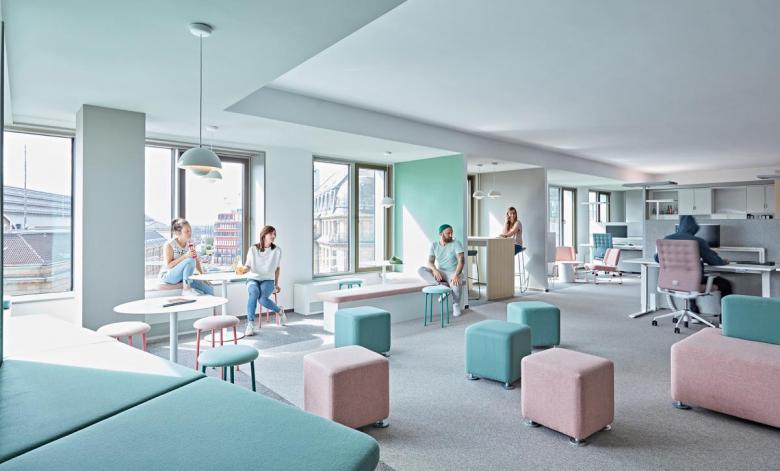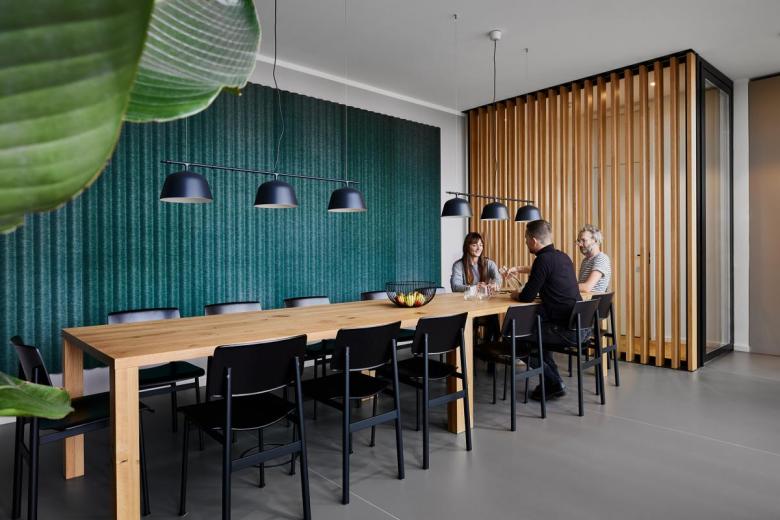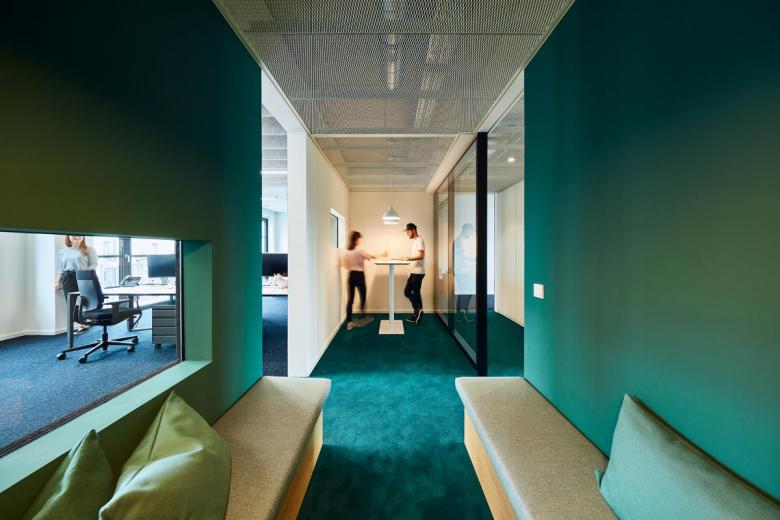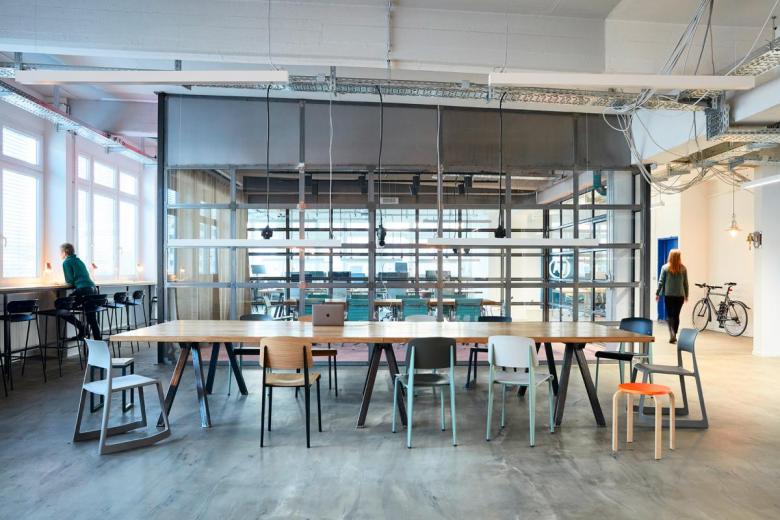Claudia and Klaus de Winder: "The drivers of the future in terms of working are the new functions that the office must fulfil to remain livable."
Thomas Geuder
19. dicembre 2022
Klaus de Winder and Claudia de Winder (Photo: Mark Seelen Photography)
Claudia and Klaus de Winder from the Berlin-based office de Winder Architekten are convinced that the office will continue to exist, albeit in a changed form. So the question is what interaction models the office must stand for in the future and what the interior design should be like to go with it.
Thomas Geuder: Mrs. and Mr. de Winder, when buildings are constructed, especially office buildings, the planning of the building and that of its interior are often carried out separately from each other, for example because the companies hiring the offices have not yet been determined at the time of construction or because they have their very own ideas about the office. How sensible is it these days to consider the building and the interior separately when it comes to offices?
kdw: From the investors' or project developers' point of view, it certainly makes sense to construct office buildings to effectively have them in stock, without knowing who the future user will be. However, the requirements of the users have changed continuously, and this is not a contemporary phenomenon. Therefore, buildings must be conceived and implemented in a much more adaptive way. We would therefore like to be involved in the conception, implementation and even the selection of buildings at a much earlier stage. We still believe in the interplay of shell and function.
cdw: The separation of interior and exterior spaces has a significant impact on the resulting atmosphere inside the building. If no harmony is achieved here, this has an impact on the users' perception. This is not necessarily obvious to everyone, but some kind of disturbing factor is often noticeable, which many cannot attribute at first.
Vattenfall Berlin Headquarters, Berlin, 2022, Vattenfall GmbH (Photo: Mark Seelen Photography)
Carlsen Publishing Campus, Hamburg, 2021, Carlsen Verlag GmbH (Photo: Mark Seelen Photography)
Hypoport, Berlin, 2020, Hypoport SE (Photo: Mark Seelen Photography)
The phase of the corona pandemic was also a time of enormously accelerated change for office workers. How did you as planners perceive the last three or so years in your daily work?
kdw: Many of the issues that are now being intensively discussed are not new to us. The need to change buildings and workspaces has been occupying us for many years, but has now rapidly become generally acknowledged. Almost from one day to the next, new global working models and locations were required, and it quickly became clear that there is simply no way back. This new situation made it necessary to create new incentives to re-establish the office as a social place.
cdw: Here we were confronted with different phenomena. On the one hand, many of our clients had the problem of "luring" their employees back to the office. On the other hand, employees started to exert pressure to finally promote togetherness and mutual exchange again.
Mozilla German Headquarters, Berlin, 2018, Mozilla Denmark GmbH (Photo: Mark Seelen Photography)
Since digitalization has significantly changed the office — let's say for around 25 years —, it has undergone changes that have always been closely linked to the new possibilities. What are today's drivers of the office of the future?
kdw: In fact, digitalization has been discussed for much longer, actually since the 1950s and 1960s, only that it was talked about under the buzzword "cybernetics" back then. In recent years, mobile devices and the use of high-speed Internet have pushed digitalization even further and made it much more flexible. In the meantime, it has become evident that it almost doesn't matter where you work when it comes to knowledge work. At the same time, however, this is also the challenge. The drivers of the future in terms of working are the new functions that the office must fulfill to remain livable; understanding the office more as a social place, both for the purpose of the company and for the employees, and not least for the urban space.
cdw: We will give more thought to linking social networks at different levels, and here we are talking about the intermingling and mutual influence and promotion of both analog and digital networks. In our opinion, the analog network is still the most effective way to communicate in a positive and constructive way. We need to keep this in mind when planning new work environments, while also taking into account the desire for hybrid communication models.
BCG Platinion, Berlin, 2022, BCG Platinion GmbH (Photo: Mark Seelen Photography)
Individuality and well-being are important factors for employee satisfaction and ultimately their productivity. Nevertheless, the ideas of this can sometimes be quite different. What tools do you use to find out what kind of working environment your clients' employees not only want but also need?
kdw: In science and technology, what you do is "measure, measure, measure". As architects, the most important thing we have to do is listen. Since there is no recipe or formula for collaboration and since it is highly individual, we must first understand the processes of the company and the needs of the employees. Almost impossible, but desirable, would be to spend some time in the company or in the work processes to understand how it works.
cdw: Yes, being able to join the current work environment undercover as an embedded architect and analyze the processes from within, that would be great! However, we usually limit ourselves to workshop series that involve the employees throughout the entire planning and construction process. So it is rather the other way around: the embedded employee.
Etventure, Berlin, 2019, etventure GmbH (Photo: Mark Seelen Photography)
Since the 1970s, many people have been dreaming of being able to work wherever they want, including on a green field in the middle of nowhere. That would be possible today. The Internet connects office workers anytime and anywhere, with audio and video, and — as some describe the near future — also in virtual spaces via avatars. Are real offices therefore no longer needed in the future?
kdw: … That's impossible to predict, #crystallball. We believe that offices will still exist in the future. But not in the way we know them; the desk as the nucleus of the office has certainly had its day. In our opinion, the Metaworld will not be able to replace the collaborative aspect of work, because work processes in general — and not least for our work as architects — are too complex for that and thrive on the moments in between. Some processes can certainly be digitalized further, perhaps even through avatars or bots.
cdw: This development is certainly unstoppable, and for many it is also an appealing idea. However, it is also associated with a loss of authenticity. The "honest and real" is in danger of being lost, and with it the values that are associated with it. Parallel worlds are all well and good, but in our opinion the most important thing still is the real world.
Danone Headquarters, Frankfurt/Main, 2018, Danone Waters Deutschland GmbH (Photo: Mark Seelen Photography)
Values, Berlin, 2021, Values Real Estate (Photo: Mark Seelen Photography)
You work in Berlin, in quite bright rooms with high ceilings, large windows and a nice view. At first glance, that sounds like a classic office setting. So is the tried-and-tested office still a good and sensible solution?
kdw: Well, our offices aren't that classic either. We are, for example, located rather as one imagines the premises of architects and designers on factory floors, in an old vinyl record factory in Kreuzberg. Bright, spacious and with a great view of the Spree River. Whatever "tried and tested" may be, but as long as the office has good flexibility, creates a distinct atmospheric quality of stay and identity-generating spaces, the physical office space will continue to exist.
cdw: The "tried and tested office" won't be buried any time soon, I'm sure of that. The added value of "tangible", direct interaction, whether it's a brainstorming session or having breakfast together, is still right at the top of the must-have list for most people.
Sinner Schrader, Frankfurt/Main, 2018, Sinner Schrader AG (Photo: Mark Seelen Photography)
Axel Springer hy, Berlin, 2018, Axel Springer hy GmbH (Photo: Mark Seelen Photography)
Klaus de Winder, Dipl.-Ing. Architekt (Berlin Chamber of Architects), born in Nordhorn, has worked as a freelance architect since 1991. His involvement in the founding of the architecture department at the Potsdam University of Applied Sciences as well as teaching experience at the TU Berlin, the Konstanz University of Applied Sciences and the University of Nova Scotia in Halifax are among his references, as are the implemented projects "Technologiehof Münster" at Bolles + Wilson in Münster and the multi-award-winning "Photonik" for sauerbruch hutton architekten. Since 1999, he has been working with architect Claudia de Winder in their own office in Berlin-Kreuzberg with a focus on office design for renowned companies from the new economy, law firms and the consulting industry.
Claudia (Caroline) de Winder, Dipl.-Ing. Architektin (Bavarian Chamber of Architects), born in Munich, has been working as a freelance architect since 1993. After various commissions in project partnership for Prof. Michael Gaenssler in Munich, she worked for Wagner Architekten and Dbm & Debis Immobilienmanagement und Grundstücksbeteiligungs GmbH in Berlin. In 1999, Claudia de Winder founded her own office in Berlin with Klaus de Winder.
A Focus on New Work, Sustainability and Home Office
Under the motto "Home of Consumer Goods", Ambiente, Christmasworld and Creativeworld will be held simultaneously for the first time from 3 to 7 February 2023 at one of the world's most modern trade fair centers. The new design of the Working area under the umbrella of Ambiente, the world's leading trade fair for the sector, will create forward-looking impulses in particular. At Ambiente Working, everything will revolve around office supplies and office equipment — with a view not only to the classic office, but also to mobile working, home offices, co-working spaces and the Future of Work.
www.ambiente.messefrankfurt.com/frankfurt/en/profile/working.html | www.messefrankfurt.com/frankfurt/en/welcome-home.html
Future of Work Academy at Ambiente in Frankfurt
The Future of Work Academy is aimed at architects, facility managers and planners, as well as retailers of office supplies and equipment. Following its successful premiere in 2017, this year eight lectures will highlight the current changes in the world of work, digital solutions for collaboration and sustainable concepts for a modern workplace. During Ambiente 2023, the Future of Work Academy will offer lectures on 4 and 5 February from 10:30 am to 2:30 pm, each of which will highlight different perspectives on the topic of work.
Lectures at the Future of Work Academy on 4 and 5 February 2023
Peter Ippolito (Ippolito Fleitz Group), Nina Delius (schneider+schumacher), Sophia Klees (jack be nimble lighting | design | innovation), Klaus K. Loenhart (STUDIO TERRAIN), Prof. Tina Kammer (InteriorPark.), Klaus de Winder (de Winder Architekten), Hans Schneider (J. MAYER H. und Partner, Architekten), Monika Lepel (LEPEL & LEPEL Architekt Innenarchitektin)
Ambiente Working – Future of Work Academy – Registration
World-Architects is content partner of Messe Frankfurt.
Articoli relazionati
-
Spotlight on Italy
on 16/05/18
-
Bologna Shoah Memorial
on 20/07/15
